‘Jewish and Homosexual’: An Exploration of Jewish LGBTQ+ Identities in the Jewish Museum London’s Collection
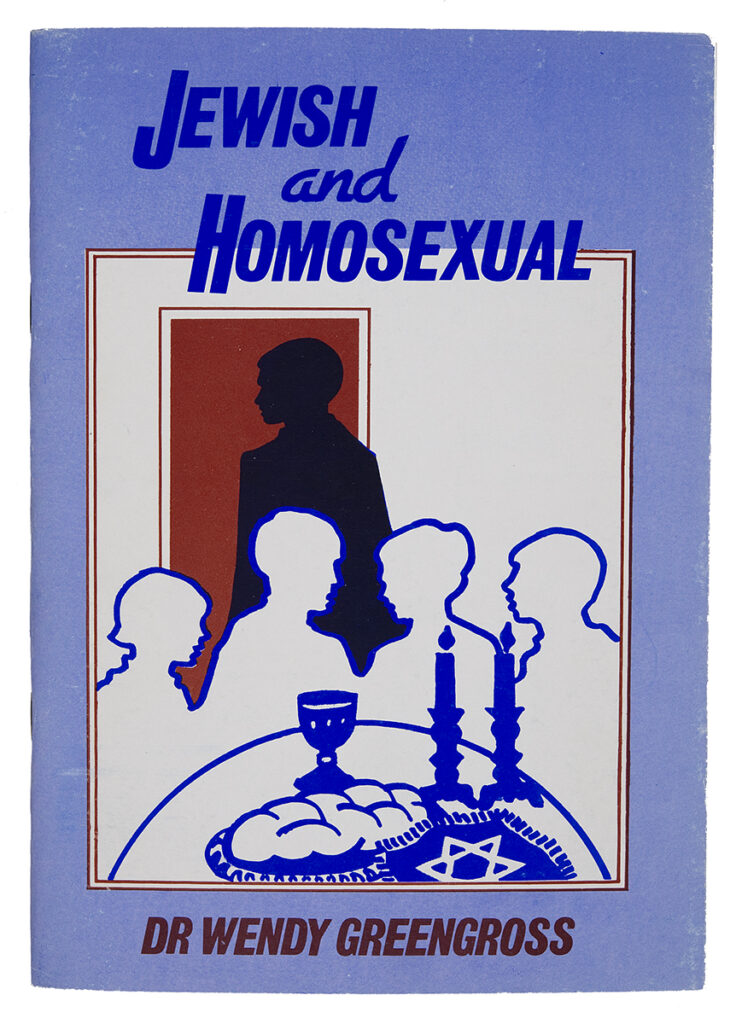
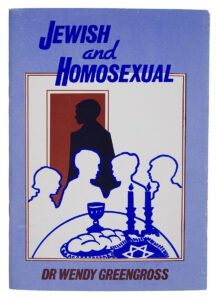
Object Number 1990.165.3
The Jewish Museum London holds over 41,000 objects in its collection. These objects tell the stories of the lives of Jewish people past and present, including those who are members of the LGBTQ+ community. Some of those narratives may be hidden to us, however this blog explores those objects from the collection that explicitly reveal the experiences of LGBTQ+ Jewish people, beginning with this booklet published in 1982.
Published by the Reform Synagogues of Great Britain, this pioneering booklet was written by sexuality, ageing and disability advocate Dr Wendy Greengross (1925 – 2012). Titled ‘Jewish and Homosexual’, it explored contemporary attitudes towards the inclusion of gay and lesbian people within Jewish spaces and communities. It starts with an introduction by Rabbi Tony Bayfield, in which he reflects on his own congregation, and how gay people within it may feel excluded by attitudes held by others. Both he and Dr Greengross argue for greater acceptance, inclusion and compassion in relation to gay and lesbian Jews. They both draw parallels with the persecution of Jewish people in their arguments for inclusion. Dr Greengross writes ‘It is distressing that Jews, who have for generations experiences religious persecution and religious suppression, should attempt to enforce any censure on some of their own co-religionists’ and the Rabbi writes ‘Jewish experience had led us to recognise a special obligation to embattled and oppressed minority groups’.
At the start, Dr Greengross writes ‘I realise that… I am going against the teachings of the ages and some may find the discussion distasteful and unnecessary…’. This tells us that the views shared by Dr Greengross and Rabbi Tony Bayfield may not have been widely held. However, other objects in the collection tell the changing story of how LGBTQ+ Jewish people have been able to express, engage with and celebrate both of these identities simultaneously.
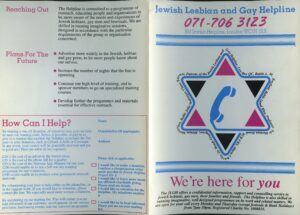
Object Number 2007.19.1
As shown by this leaflet in our collection, Dr Greengross later went onto become a patron of the Jewish Lesbian and Gay Helpline, along with others such as out gay Rabbi Lionel Blue and out lesbian Jewish actress Miriam Margolyes. The helpline, established in 1992, aimed to of provide ‘information of interest to Jewish lesbians and gay men’, as well as ‘confidential counselling for Jewish lesbians, gay men and bisexuals, their family and friends.’ It also provided information about safer sex and HIV and AIDS, as did the Jewish AIDS Trust (established 1988). They published booklets such as the one shown here that talked about AIDS for a Jewish perspective, such as highlighting Jewish practices that did not transmit HIV such as sharing a Kiddush cup and blowing a Shofar.
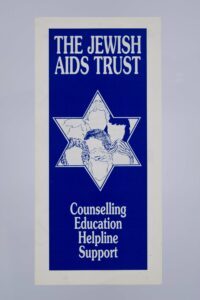
Object Number 1994.29.2
Although these objects may demonstrate the more painful side of being Jewish and gay, happier examples of LGBTQ+ Jewish people engaging with their faith are also to be found. This leaflet advertises a Lesbian and Gay Purim Ball in Islington, likely from the 1990s. Purim, with its foundation in the concealing and revealing identities, is viewed by many as connected to the LGBTQ+ community.

Object Number 2007.19.2
And what about now, in the 21st century? Recent acquisitions by the Jewish Museum London reveal a marked change in attitudes and experiences from the publication of ‘Jewish and Homosexual’. Dr Greengross wrote, ‘In Britain, it is difficult to be overtly gay and at the same time be a practising member of a religious community.’ This photo taken by photographer Judah Passow shows an openly gay couple dancing at the end of a Simchat Torah service at a Liberal synagogue in West London in 2010. They are, in fact, able to the overtly gay within their community during a religious festival.
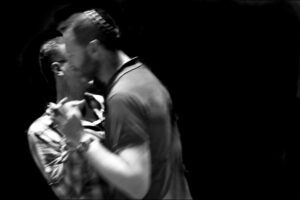
Object Number 2012.25.60. Copyright Judah Passow.
To continue the vital work of representing of the diversity of the Jewish community in Britain, in recent years the Jewish Museum London launched the Inclusive Judaism project. The project works directly with Jewish communities in the UK to collect images, including these images showing how Jewish people have been able to express their LGBTQ+ identities through items of religious attire. This first image shows Mie Jensen, a PhD candidate who researches LBQ Jewish womens’ lived experiences, wears a rainbow kippah whilst praying at the Kotel. Of this, she says ‘… for me the kippah is a very important Jewish symbol, because it was originally for men and then women started adopting it during second wave feminism, and then the rainbow kippah to many can be seen as making a political statement and it’s a way to reclaim and reassert spiritual agency. It’s a way to feel connected to Judaism, as well creating this more egalitarian cultural legacy.’
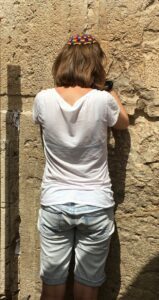
Object Number 2021.3. Copyright Lotte Astrup Jensen
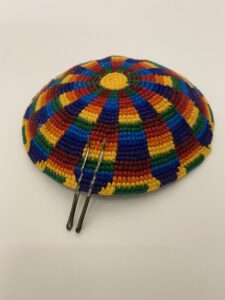
Object Number L2021.5. Copyright Mie Jensen.
These next images show a hand embroidered kippah, as well as a placard made for London Trans Pride 2022. The kippah is embroidered in the Trans Pride colours and shows the Trans symbol inside a Star of David, demonstrating how the owner and creator links their Jewish and Trans identities. The creator says ‘My transness is a sacred and intrinsic part of my Jewish identity.’ Although the Trans community is not mentioned in Dr Greengross’s booklet, they are still an important part of the LGBTQ+ community that continues to fight for acceptance today.
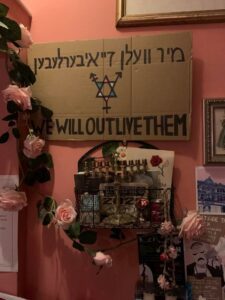
Object Number 2023.3.3. Copyright F. Moore.
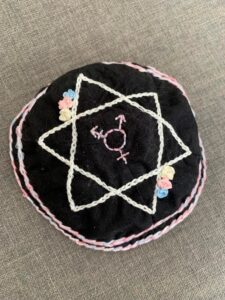
Object Number 2023.3.1. Copyright F. Moore.
When Dr Greengross was writing her booklet, the concept of same-sex marriage, let alone Jewish same-sex marriage, seemed hard to fathom. She wrote, ‘Judaism is certainly not yet ready to accept the marriage of two persons of the same sex, but it may be that with changing attitudes, even this may not be unknown in the future, although ‘marriage’ may be an inappropriate word to use’. However, same-sex marriage became legal in the UK in 2015 and this photo shows the wedding of Sophie Slowe and Jessica Salkinds in 2021 at West London Synagogue. This was the same synagogue that Sophie’s parents were married at 40 years earlier. Of being able to get married in a synagogue, Sophie said ‘As two gay, Jewish women who both grew up in London, it was a moment neither of us had even dared to imagine but that we will both treasure forever. It is a testament to the progressive and inclusive nature of WLS that two women can stand under a chuppah in the Santuary and say “I do”’. The Rabbi, Rabbi David Mitchell, had the first same-sex marriage in the UK’s Reform Jewish Community in 2015.

Object Number 2022.1.2. Copyright: Albert Palmer
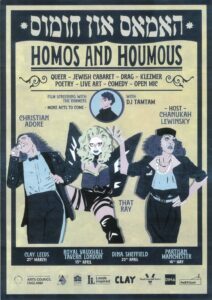
Object number 2022.8.1. Copyright Dex Grodner. Illustrator Fredrik Andersson. Designer Jake Elwes.
Language has also changed since 1982. Dr Greengross wrote that the word ‘Queer’ was as offensive as some anti-Semitic slurs, however since then it has been reclaimed by the LGBTQ+ community and some use it as the primary identifier for their sexuality. This poster for the 2020 tour of ‘Homos and Houmous’ identifies it as a ‘Queer’ and a ‘Jewish Cabaret’. ‘Homos and Houmous’ is a queer Jewish performance collective established in 2016 and hosted by drag artists Chanukah Lewinsky and That Ray. In an interview, Chanukah Lewinsky said of Judaism as a space for exploring queer identity, ‘Judaism is inherently theatrical. There’s something camp about our gender relations’.
The Jewish Museum London continues to collect images and objects such as those shared in this blog that relate to the diversity of experience of the Jewish community as part of our ongoing Inclusive Judaism project. If you have any images that you feel express your LGBTQ+ and Jewish identity that you would like to donate, please email [email protected].